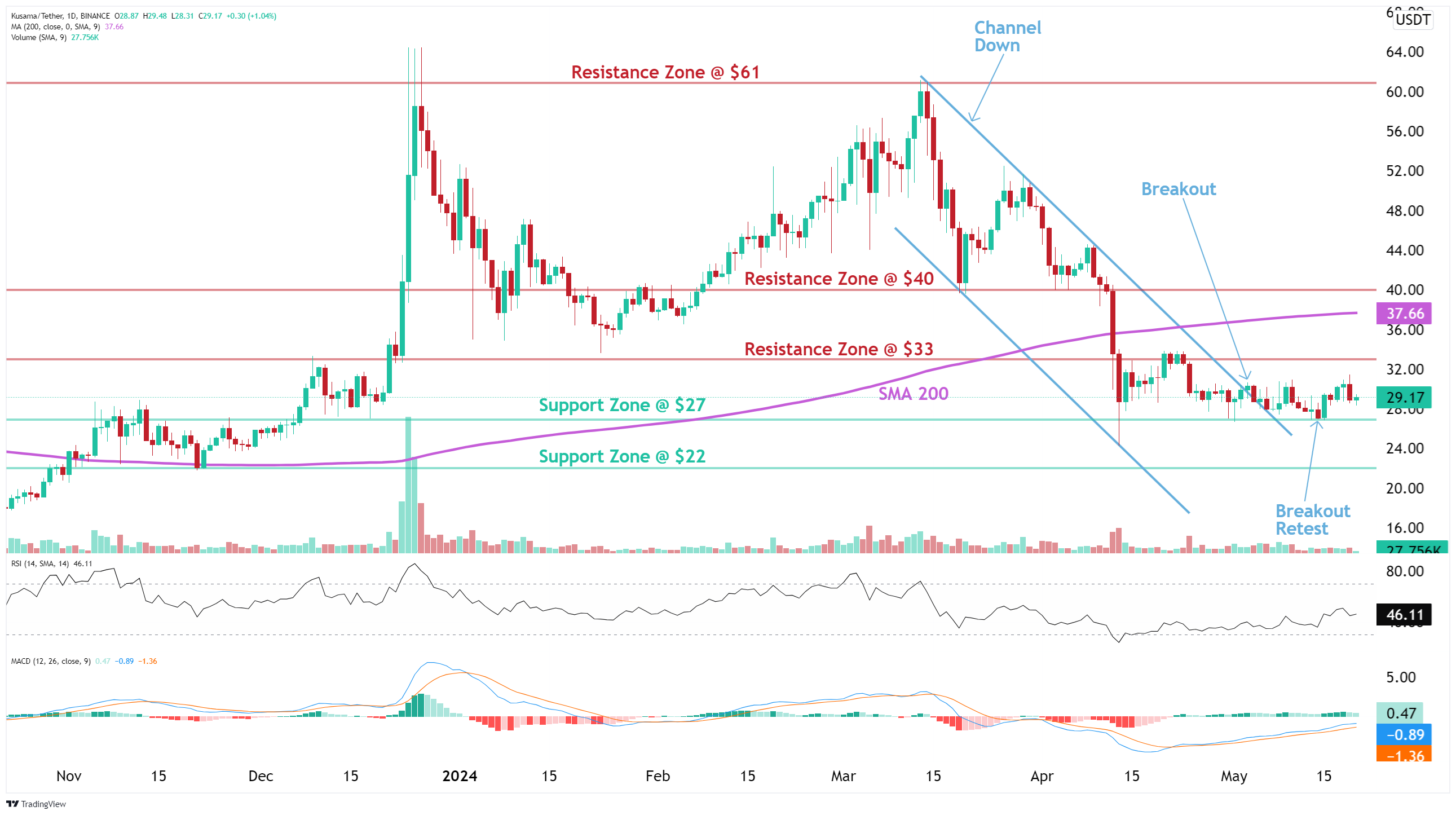Kusama (KSM) Analysis
Kusama (KSM) Analysis
In addition to automated chart patterns, altFINS’ analysts conduct technical chart analyses of top 30 cryptocurrencies. We call these Curated Charts and they evaluate 5 core principals of technical analysis: Trend, Momentum, Patterns, Volume, Support and Resistance.
Kusama (KSM) technical analysis:
Trade setup: Bullish breakout from a Channel Down pattern could signal near-term strength, with +10% upside to $33 resistance. Stop Loss (SL) at $26.40. This is a riskier trade setup because it’s a trend reversal not a trend continuation setup. It’s against the overall downtrend. (set a price alert).
Pattern: Price was trading in a Channel Down pattern. With complete patterns (i.e. a breakout) – initiate a trade when the price breaks through the channel’s trendlines, either on the upper or lower side. When this happens, the price can move rapidly in the direction of that breakout. Learn to trade chart patterns in Lesson 8.
Trend: Downtrend across all time horizons (Short- Medium- and Long-Term).
Momentum is Mixed as MACD Line is above MACD Signal Line (Bullish) but RSI < 45 (Bearish). MACD Histogram bars are declining, which suggests that momentum is weakening.
Support and Resistance: Nearest Support Zone is $27, then $22. The nearest Resistance Zone is $33 (previous support), then $40 and $61.
See live Kusama (KSM) chart here
See more curated charts of coins with technical analyses.
Recent news and research:
Bifrost launches on Kusama-based Karura Swap with 200,000 BNC in rewards
Kusama (KSM) sees its first sold-out parachain auction
Primer on Polkadot & Kusama Parachains
Polkadot, Kusama Jump Ahead of Next Parachain Auction
Power of community: Moonriver receives over 200,000 KSM ahead of Kusama launch
Kusama’s DeFi Hub Karura Raises $100 Million in KSM Token Sale Ahead of Parachain Auction
Gavin Wood Announces Kusama Parachain Auctions
Polkadot (DOT) and Kusama (KSM) skyrocket in price after attracting $30M in funding
Find more real-time news here.
What is Kusama (KSM)?
Find full description and news on altFINS platform.
Overview
Kusama is an early, experimental version of Polkadot that exists as an independent network. It intends to act as a sandbox for developers, allowing teams to deploy and test pre-release versions of their projects before launching them on Polkadot’s mainnet. Kusama will also serve as a testbed for Parity Technologies leading up to the mainnet launch of Polkadot. Like its sister chain, Kusama uses a native token, KSM, to power computation and give holders the ability to participate in securing the network and voting on upgrade proposals.
Consensus
Kusama uses Nominated Proof-of-Stake (NPoS), comprising the roles of validators and nominators to maximize chain security. Validators take the role of both validating blocks and guaranteeing the finality of the chain, while nominators can help choose the set of validators by indicating their support weighted by KSM.
Usage details
KSM holders can use their tokens as follows: Bond to the network to validate transactions or launch a parachain Pay for transaction and messaging fees Vote on governance proposals or nominate validators into the capped validator set DOTs investors from previous token sales were able to claim a proportionate amount of KSM at their choosing. Parity Technologies also offered a KSM “frictional faucet” (i.e., one that limits the outputs per account) and issued token grants for those that did not invest in the DOT token sales. Parity Technologies and the Web3 Foundation also reserved 1% of the initial DOT supply (100,000 tokens) to Kusama stakeholders and its community. This reward serves to incentivize token sale investors and those new to Polkadot to participate within its sister network. Neither company has announced how they plan to distribute these DOT rewards.
